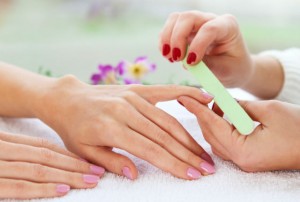
Researchers from the University of Nottingham have found that daily trimming of fingernails and toenails in an effort to make them look better may actually be harmful and potentially may lead to serious nail conditions.
According to the study, published October 17 in IOP Publishing’s journal Physical Biology, if you’re trimming your nails poorly on a regular basis, it can tip the “fine balance of nails, causing residual stress to occur across the entire nail.”
The residual stress that results may promote a change in shape or curvature of the nail over time which, in turn, can lead to serious nail conditions, researchers say.
The study’s lead author Cyril Rauch noted, “It is remarkable what some people are willing to do to make their nails look good, and it is in this context that I decided to look at what we really know about nails. Reading the scientific literature on nails I quickly realised that very little physics or maths had been applied to nails and their conditions.”
Rauch added, “Looking at our results, we suggest that nail beauty fanatics who trim their nails on a daily basis opt for straight or parabolic edges, as otherwise they may amplify the imbalance of stresses which could lead to a number of serious conditions.”
For this study, the researchers reportedly focused specifically on ingrown toenails which, to date, lacks satisfactory treatment, while the causes also remain largely unknown. They accounted for the “strong adhesion of nails to their bed through tiny, microscopic structures, which allow the nail to slide forwards and grow in a ‘ratchet-like’ fashion by continuously binding and unbinding to the nail,” according to ScienceDaily.com.
Researchers also took into account mechanical stresses and energies associated with the nail to come up with an overall shape equation that revealed when the balance between growth and adhesive stress is broken. This can occur when a nail grows too fast or too slow, or the when the number of adhesive structures change, causing a residual stress across the entire nail resulting in a change of shape over time.
While residual stress may occur on any fingernail or toenail, they report the stress is greater for nails that are larger in size and have a flatter edge, explaining why ingrown toe nails predominantly occur in the big toe.
This residual stress may be brought about by a number of factors, such as age or change in metabolic activity, but their equations also found that poor nail trimming often amplifies the stress.
 While humans who are fanatic about trimming their nails should certainly keep this in mind, the researchers are hoping to apply this information to farm animals and conditions associated with their hooves, which can threaten their lives.
While humans who are fanatic about trimming their nails should certainly keep this in mind, the researchers are hoping to apply this information to farm animals and conditions associated with their hooves, which can threaten their lives.
Rauch said, “At a time when securing food across the world is important, understanding the physics of hooves has never been so essential to sustain agriculture and food production. I believe that physics can make a difference by promoting a new type of evidence-based veterinary medicine and help the veterinary and farrier communities by devising trimming methods to alleviate pain and potentially remove the cause of serious conditions.”
-The Alternative Daily
Sources:
http://www.sciencedaily.com/releases/2014/10/141017093122.htm

